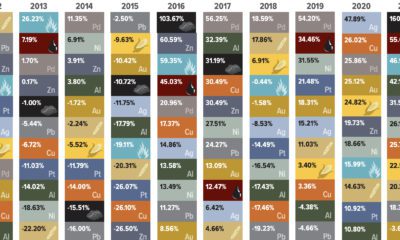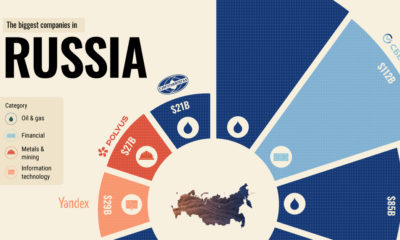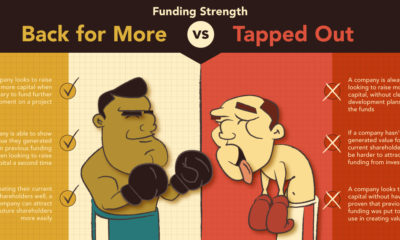The Oscar: How It’s Made, and What It’s Worth
Presented by: JMBullion The “Academy Award of Merit”, more commonly known as an Oscar, has been awarded since 1929. The modern Oscar stands 13.5 inches tall with a weight of 8.5 lbs, and it is made of solid bronze with a electroplated coating of 24-karat gold. However, the world’s most beloved trophy wasn’t always made this way. Here’s the evolution of how an Oscar is made, and what people are willing to pay to get their hands on one.
The Evolution of the Award
1928: The original Oscar was sculpted by Los Angeles artist George Stanley. The design was based on sketches by MGM art director Cedric Gibbons, who came up with the idea of a knight standing on a reel of film gripping a crusader’s sword. 1929: The first ever Oscar was presented at the initial awards banquet on May 16, 1929 to Emil Jannings for Best Actor. It was made of gold-plated solid bronze. 1930s: The bronze was abandoned in favor of britannia metal, a pewter-like alloy which is then plated in copper, nickel silver, and finally, 24-karat gold. World War II: Due to a metal shortage, Oscars were made of painted plaster for three years. After the war, the Academy invited recipients to redeem the plaster figures for gold-plated metal ones. 1983: R.S. Owens and Company, a Chicago-based awards manufacturer, takes over the contract to build Oscars. 2016: The Academy announced that New York-based Polich Tallix will help return the statuette closer to its original design.
The New Oscar
Using a cast bronze Oscar from 1929, Polich Tallix artisans have restored subtle features of George Stanley’s original sculpture, which was based on sketches by MGM art director Cedric Gibbons. This was done by creating a digital scan of the 1929 statuette, and then 3D printed and molded so the form could be cast in wax. Here’s how each new Oscar is made:
The modern wax versions are dipped in a ceramic shell slurry for ten coats. Once the shell is cured, it is fired in an oven at 1600° F. Bronze at 1860° F is then poured into the hot ceramic shell and allowed to cool overnight. The next morning, the bronze castings are broken out of the ceramic shell and the plumbing system that guides the metal into the body of the casting is cut off. The castings are then sanded to a mirror polish finish and electroplated with a permanent layer of 24-karat gold by Epner Technology. The statuette’s bronze base receives a smooth black patina, which is hand-buffed to a satin finish.
The time required to produce 50 statuettes in this manner is about three months.
“With the help of some 21st century technology, we’re able to honor the Oscar’s proud beginnings,” said Academy President Cheryl Boone Isaacs. “The new statuette exemplifies impeccable craftsmanship and the enduring nature of art.”
What’s an Oscar Worth?
Oscars on the open market can command up to millions of dollars. However, this wouldn’t be the case if the Academy had its way. Since 1950, the Academy has not allowed winners to keep Oscars unless a First Right of Refusal agreement is signed. It stipulates that an Oscar cannot be sold by a winner unless it is offered to the Academy first for the sum of $1. Here’s what an Oscar is really worth: According to R.S. Owens, the longtime maker of modern-day Oscars up until this year, the cost to produce one statuette is $400. Assuming $1,200/oz gold, a standard gold electroplated coat of 15 millionths of an inch thick, and a 2.2 sq. ft surface area, the melt value of the gold coating alone is $57.40. A hypothetical solid gold Oscar? It would weigh 18 lbs and have a melt value of $330,522.
Stars Hit the Bid
Since 1929, approximately 150 Oscars have been sold on the open market, with around half of them being grey-market sales from the post-1950 era.
Here’s some stars that have bought or bid for Oscars during their careers. All numbers are converted to 2016 USD:
David Copperfield – $299,000 Oscar for Best Director to Michael Curtiz (Casablanca, 1942)
Copperfield bought it in 2003, and kept it in his bedroom. He auctioned it off for over $2 million in 2012
David Copperfield – $907,000 (failed bid) Oscar for Best Screenplay to Orson Welles (Citizen Kane, 1941)
Copperfield tried to acquire a second Oscar in 2011, but was outbid by a private buyer
Michael Jackson – $2.19 million dollars Oscar for Best Picture (Gone With the Wind, 1939)
Bought in 1999 for a record price of $1.54 million at the time, Michael paid far higher than the pre-sale estimated price of $300,000.
Steven Spielberg – $917,000 Oscar for Best Actor to Clark Gable (It Happened One Night, 1943)
Spielberg bought the Oscar, and donated it back to the Academy for safekeeping
Steven Spielberg – $773,000 Oscar for Best Actress to Bette Davis (Jezebel, 1938)
Spielberg bought the Oscar, and donated it back to the Academy for safekeeping
on Did you know that nearly one-fifth of all the gold ever mined is held by central banks? Besides investors and jewelry consumers, central banks are a major source of gold demand. In fact, in 2022, central banks snapped up gold at the fastest pace since 1967. However, the record gold purchases of 2022 are in stark contrast to the 1990s and early 2000s, when central banks were net sellers of gold. The above infographic uses data from the World Gold Council to show 30 years of central bank gold demand, highlighting how official attitudes toward gold have changed in the last 30 years.
Why Do Central Banks Buy Gold?
Gold plays an important role in the financial reserves of numerous nations. Here are three of the reasons why central banks hold gold:
Balancing foreign exchange reserves Central banks have long held gold as part of their reserves to manage risk from currency holdings and to promote stability during economic turmoil. Hedging against fiat currencies Gold offers a hedge against the eroding purchasing power of currencies (mainly the U.S. dollar) due to inflation. Diversifying portfolios Gold has an inverse correlation with the U.S. dollar. When the dollar falls in value, gold prices tend to rise, protecting central banks from volatility. The Switch from Selling to Buying In the 1990s and early 2000s, central banks were net sellers of gold. There were several reasons behind the selling, including good macroeconomic conditions and a downward trend in gold prices. Due to strong economic growth, gold’s safe-haven properties were less valuable, and low returns made it unattractive as an investment. Central bank attitudes toward gold started changing following the 1997 Asian financial crisis and then later, the 2007–08 financial crisis. Since 2010, central banks have been net buyers of gold on an annual basis. Here’s a look at the 10 largest official buyers of gold from the end of 1999 to end of 2021: Rank CountryAmount of Gold Bought (tonnes)% of All Buying #1🇷🇺 Russia 1,88828% #2🇨🇳 China 1,55223% #3🇹🇷 Türkiye 5418% #4🇮🇳 India 3956% #5🇰🇿 Kazakhstan 3455% #6🇺🇿 Uzbekistan 3115% #7🇸🇦 Saudi Arabia 1803% #8🇹🇭 Thailand 1682% #9🇵🇱 Poland1282% #10🇲🇽 Mexico 1152% Total5,62384% Source: IMF The top 10 official buyers of gold between end-1999 and end-2021 represent 84% of all the gold bought by central banks during this period. Russia and China—arguably the United States’ top geopolitical rivals—have been the largest gold buyers over the last two decades. Russia, in particular, accelerated its gold purchases after being hit by Western sanctions following its annexation of Crimea in 2014. Interestingly, the majority of nations on the above list are emerging economies. These countries have likely been stockpiling gold to hedge against financial and geopolitical risks affecting currencies, primarily the U.S. dollar. Meanwhile, European nations including Switzerland, France, Netherlands, and the UK were the largest sellers of gold between 1999 and 2021, under the Central Bank Gold Agreement (CBGA) framework. Which Central Banks Bought Gold in 2022? In 2022, central banks bought a record 1,136 tonnes of gold, worth around $70 billion. Country2022 Gold Purchases (tonnes)% of Total 🇹🇷 Türkiye14813% 🇨🇳 China 625% 🇪🇬 Egypt 474% 🇶🇦 Qatar333% 🇮🇶 Iraq 343% 🇮🇳 India 333% 🇦🇪 UAE 252% 🇰🇬 Kyrgyzstan 61% 🇹🇯 Tajikistan 40.4% 🇪🇨 Ecuador 30.3% 🌍 Unreported 74165% Total1,136100% Türkiye, experiencing 86% year-over-year inflation as of October 2022, was the largest buyer, adding 148 tonnes to its reserves. China continued its gold-buying spree with 62 tonnes added in the months of November and December, amid rising geopolitical tensions with the United States. Overall, emerging markets continued the trend that started in the 2000s, accounting for the bulk of gold purchases. Meanwhile, a significant two-thirds, or 741 tonnes of official gold purchases were unreported in 2022. According to analysts, unreported gold purchases are likely to have come from countries like China and Russia, who are looking to de-dollarize global trade to circumvent Western sanctions.
There were several reasons behind the selling, including good macroeconomic conditions and a downward trend in gold prices. Due to strong economic growth, gold’s safe-haven properties were less valuable, and low returns made it unattractive as an investment.
Central bank attitudes toward gold started changing following the 1997 Asian financial crisis and then later, the 2007–08 financial crisis. Since 2010, central banks have been net buyers of gold on an annual basis.
Here’s a look at the 10 largest official buyers of gold from the end of 1999 to end of 2021:
Source: IMF
The top 10 official buyers of gold between end-1999 and end-2021 represent 84% of all the gold bought by central banks during this period.
Russia and China—arguably the United States’ top geopolitical rivals—have been the largest gold buyers over the last two decades. Russia, in particular, accelerated its gold purchases after being hit by Western sanctions following its annexation of Crimea in 2014.
Interestingly, the majority of nations on the above list are emerging economies. These countries have likely been stockpiling gold to hedge against financial and geopolitical risks affecting currencies, primarily the U.S. dollar.
Meanwhile, European nations including Switzerland, France, Netherlands, and the UK were the largest sellers of gold between 1999 and 2021, under the Central Bank Gold Agreement (CBGA) framework.
Which Central Banks Bought Gold in 2022?
In 2022, central banks bought a record 1,136 tonnes of gold, worth around $70 billion. Türkiye, experiencing 86% year-over-year inflation as of October 2022, was the largest buyer, adding 148 tonnes to its reserves. China continued its gold-buying spree with 62 tonnes added in the months of November and December, amid rising geopolitical tensions with the United States. Overall, emerging markets continued the trend that started in the 2000s, accounting for the bulk of gold purchases. Meanwhile, a significant two-thirds, or 741 tonnes of official gold purchases were unreported in 2022. According to analysts, unreported gold purchases are likely to have come from countries like China and Russia, who are looking to de-dollarize global trade to circumvent Western sanctions.














